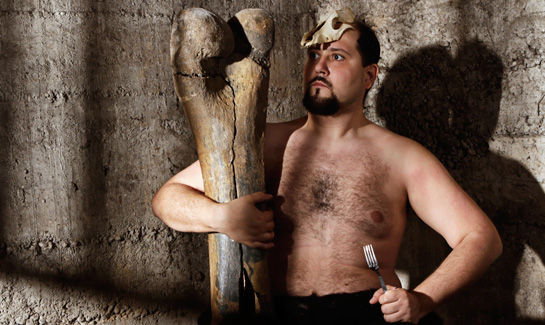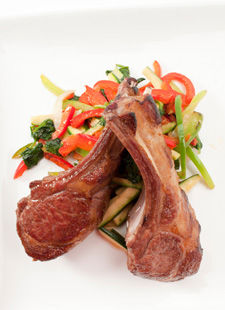
By Jim Gerard
It’s been 10,000 years or so since humans lived in a brutal, savage world where dinner depended on killing a mastodon and the average life expectancy was about 30 years.
Yet, in our technologically evolved era, a diet based on the presumptive knowledge of our Paleolithic ancestors’ “lifestyle” has captivated weight-conscious Americans. The Paleo Diet: Lose Weight and Get Healthy by Eating the Foods You Were Designed to Eat, by Dr. Loren Cordain, has been a bestseller since it was published in late 2010, and its thousands of devotees are following its precept to go primitive.
These latter-day Paleoliths believe that many of our society’s most virulent ailments, including cancer and heart disease, as well as other diseases attributed to our fast-food culture (such as type 2 diabetes), have a much earlier origin—the Neolithic period, when man discovered agriculture. Their premise is that our bodies haven’t evolved enough to handle “processed foods,” a category that encompasses everything from milk, to bread, to Twinkies.
As an alternative, they’ve chosen—arbitrarily, say their critics—to mimic the diet of our hunter-gatherer ancestors.
Since Paleolithic man lived before the agricultural revolution, his diet is thought to have been comprised of wild game (the hunted) and fruits and vegetables (the gathered). However, as a compromise with modern society—and because our supermarket shelves are not exactly brimming with saber-toothed tiger meat—the Paleo diet has been adapted to include readily obtainable modern foods, such as domesticated plants and animal meat (although wild game and grass-fed beef are preferred for their higher levels of omega-3 fatty acids).
Taboo are grains, legumes, dairy products, salt, refined sugar and processed oils, and alcohol. In short, if a caveman didn’t eat it, neither should we. Certain proponents of the Paleo diet say that we should derive roughly two-thirds of our food from animals and one-third from plants. Consequently, the Paleo diet is high in protein and fat and relatively low in carbohydrates. (A typical ratio is roughly 40/40/20, although there is some dispute among adherents as to what ratio is optimal.)
Haven’t We Heard This All Before?
If you’re starting to feel a creeping sense of Atkins déjà vu, you’re justified—to an extent. Dr. Jacqueline Berning, professor of nutrition at the University of Colorado in Colorado Springs and sports dietitian for the Cleveland Indians and Colorado Rockies, says that while the Paleo and Atkins diets have similar nutrient ratios, Paleo more closely resembles the Zone diet in its allowance of carbohydrates from fruits and vegetables (while the Atkins diet doesn’t allow any carbs at all in the first two weeks).
Jim White, R.D., a spokesman for the American Dietetic Association, adds that the Paleo diet promotes “much higher-quality foods.” For example, White says that Atkins urged his followers to consume cheese and bacon, whereas Paleo recommends nuts and heart-healthy oils.
Marjorie Nolan, M.S., R.D., another ADA spokesperson, agrees that while the Atkins and Zone diets advocate eating processed foods (for example, their own nutrition bars), the Paleo diet emphasizes whole and organic foods. “The difference isn’t the ratio of fat to protein to carbs, but the source of those nutrients.”
The theory behind the Paleo diet is not new. (Cordain first introduced his premise in 1985.) Its wave of current popularity is propelled by both societal trends—the whole/raw food movement, a catch-all solution to the obesity epidemic—and good, old-fashioned publicity, even the negative kind. (U.S. News & World Report rated it one of the worst diets to follow.)
Anecdotal Evidence vs. Scientific Evidence
While its adherents claim that it’s a healthy, sure-fire weight-loss regimen, dietary experts aren’t swayed. Berning says, “There’s very little science—very few clinical trials—justifying their claims.”
Alesh Houdek, who had success following the Paleo diet, writing in the Atlantic Monthly admitted, “There are unfortunately no conclusive long-term studies on either [Paleo or Atkins], and the long-term effects of low-carb diets are not truly understood. All the positive evidence for Paleo is first-person and anecdotal.”
“While reducing processed grains and dairy can lower your risk of heart disease,” explains Nolan, “a lot of research says we really don’t know how our Paleolithic ancestors ate. They probably consumed a lot of starchy and root vegetables—even more than meat—which raises the question: Is the problem the fundamental foods or the processing of them? I think it’s the processing.”
Complicating the issue is the debate among dietitians as to what constitutes a processed food. “If I use sugar to make canned peaches,” Berning asks, “am I making it a processed food? What about frozen berries?”
While White feels that the Paleo diet may be effective for people with gluten intolerance, Dr. Felicia Stoler, exercise physiologist and president of the Greater New York chapter of the American College of Sports Medicine, demurs: “Bread has been around for thousands of years, which means it can’t be that harmful. Rice is very popular everywhere. Something about starchy carbs is very appealing to most humans.”

This brings us to the state of our knowledge of both evolution and Paleolithic man, whose diet has been inferred from historical and ethnographic studies of modern-day hunter-gatherer tribes as well as archaeological and anthropological finds.
Many experts claim that this evidence, on which the Paleo diet leans, is ambiguous, to say the least. One objection is that modern man differs too much (especially in the proportion of brain-to-gut mass) from his Paleolithic ancestors to construct a viable evolutionary parallel.
“Human DNA Didn’t Freeze in Place at Some Mythical Peak”
Another brickbat is that our evaluation of Paleolithic man is inaccurate. Jennifer Pinkowski, writing in Time magazine, said, “For one thing, there was no single Paleolithic ‘lifestyle.’ Survival in Ice Age Europe, for instance, was vastly different from life on the African savannah, requiring different diets, behaviors and genetic adaptations. For another, human DNA didn't freeze in place at some mythical peak. In fact, we're still evolving.” Nolan concurs: “Within two to three generations, we can adapt to different foods in terms of enzyme development and digestion. So we’ve had more than enough time to adapt to agricultural products.”
Berning feels there are too many unknown factors. “Paleolithic man only lived to be 30 [years] or so. How do we know he didn’t get heart disease or cancer? Also, unlike the Neolithic people who invented agriculture, he experienced periods of famine. So is a man with a short life expectancy and periods of famine a valid model? Plus, the other side of the equation isn’t addressed—Paleo man was a hunter-gatherer, and got plenty of exercise,” which may have helped him burn off all that animal fat he consumed.
Nolan also questions the use of studies of contemporary hunter-gatherers as a window into our ancestors, and Stoler thinks that the obesity problem associated with the Western diet is too new a phenomenon to have had its source in our ancient past. “We sit more on our rear ends, which is why they’ve evolved to be bigger. It’s all environment.”
Objections to the Paleo diet are also based on practical grounds. Berning asks, “Is it sustainable? Professional people don’t have time to hunt wild game.”
Nolan says that the diet’s reliance on “natural” foods isn’t realistic. “Most people eat farm-raised everything, and we can’t even be sure of foods that claim to be organic, since the Food and Drug Administration hasn’t defined it.”
Is the Paleo Diet Even Healthy?
Doubts about the Paleo diet based on historical and practical reasoning, while numerous, pale next to the health and nutritional shortcomings people find in it.
Derek Grabert, education assistant with the National Strength and Conditioning Association, feels that Paleo’s injunctions against dairy products and grains buck nutritional sense.
“Much research suggests dairy is part of a healthy diet, and the research that doesn’t is based on the consumption of high-fat dairy. Also, many dairy products are fortified with vitamin D. And whole grain products are high in fiber, which decreases the risks of colon cancer and heart disease. Americans already don’t get enough of either vitamin D or fiber.”
Eliminating foods such as grains and legumes, which have many benefits, doesn’t seem wise to ADA spokesman White. He adds: “An excessive protein diet—which Paleo is, despite its claims—can make you gain weight, lose calcium and tax your kidneys. I also worry about the risk of hypoglycemia in general, and inadequate energy levels for athletes, who need more carbs.”
Berning points to the potential problem of not consuming enough calcium. “We have a huge problem with osteoporosis—and now you’re telling people to avoid dairy?”
Stoler thinks that the Paleo premise defies decades of nutritional consensus that meat- and fat-based diets cause cancer and heart disease. “Not one study mentions plant-based diets. Most countries eat plant-based diets. If everybody else has been doing it for hundreds of years, that’s probably how we should be eating.”
Finally, Paleo’s promises of weight loss are undermined by the lack of long-term research. “I’d like to see studies of people who stayed on a low-carb diet for five years,” says White. “In my experience, over the long term they fail miserably. They don’t feel well, or they can’t resist the lure of carbs. As for athletes, their workouts will suffer, because they won’t have enough energy.”
Despite the criticism, some of our sources acknowledge beneficial aspects of the diet—specifically, its emphasis on antibiotic-free animals, natural foods, no preservatives and low sugar. Yet, they admit that Paleo-philes have to adhere to it stringently and at length to see real improvement.
__________________________________________________________________________

Jim Gerard is an author, journalist, playwright and stand-up comic. He has written for the New Republic, Travel & Leisure, Maxim, Cosmopolitan, Washington Post, Salon, Details, New York Observer, and many other magazines. For more information, visit his site at www.gangof60.com.